The Indian film RRR opened to record box office success earlier this year, and then proceeded to amass a worldwide cult following after its Netflix debut in May—and it’s easy to see why. It’s an incredible spectacle of a film that mythologizes revolutionary leaders from India. The fights are outrageous, the emotion is heightened to unbelievable levels, and the message is one of hope and inspiration.
But how does RRR achieve such highs? Why has this Tollywood film (not the same as Bollywood, by the way) aroused so many people and left them clamoring for more movies like it? While the movie’s narrative isn’t necessarily difficult to understand, RRR is actually quite complex in its visual system. There are so many significant moments of imagery and symbolism throughout that it can actually be quite daunting to keep track of it all.
So hopefully I can help. In this article, I will highlight ten important shots that I believe create a better understanding of why RRR is such a powerful film. The article is split into five sections, with each section highlighting two images that either contrast one another or create harmony when paired together.
The importance of culture and family
The opening scene is a great way to introduce the two opposing parties of the film: the British Raj (the oppressors) and the Gond tribe (the persecuted). There’s a lot of great imagery in this scene that tells us about each party’s values—including two particular shots that highlight a major tension of the film and a central conflict of the Crown rule in India.
The film opens with Malli singing a song for Catherine, the wife of the tyrannical governor Scott Buxton. Catherine is mesmerized by the song and throws a few coins to Malli’s mother, Loki. Malli’s mother, however, has no idea that Catherine has just bought Malli. And when Loki tries to get her daughter back, the “purchase” becomes an abduction.
Loki drops in front of Catherine’s car and begs for her daughter to be returned. And because she won’t get out of the way, a sergeant pulls out his gun to shoot Loki in the head. But before he can shoot, Buxton stops him and gives a speech:
“Do you comprehend the value of the bullet in your barrel? It was manufactured in an English factory using English metals. It crossed the seven seas in an English vessel. By the time it reached the barrel of your gun, it cose One Pound. One Pouts Terling! And you want to waste it on brown rubbish?”
The sergeant then puts his gun away, grabs a lot, and hits Loki upside the head with it, knocking her out cold. Which is when we get this telling image:

For Loki, the money didn’t matter at all—she just wanted her daughter back at home. But the British empire treasures wealth and materials (think about the speech just given by Buxton) over the Gond tribe’s familial values. The British know nothing of Malli’s place in the tribe and don’t care how devastating it would be to remove her. Catherine just wants to flaunt a piece of Indian culture as a presentation of her status. Malli might as well be just another fixture in Catherine’s palace.
Thus, the bloody hand holding the coins becomes a powerful image. It showcases the pain and suffering many people experienced as the British Raj used its wealth and power to break families and customs apart. But the hand is also extended, reaching for her daughter. There is hope and longing expressed in the face of defeat.
This becomes the driving force of the movie. It is a sworn duty for Bheem (played by N. T. Rama Rao Jr., aka Jr NTR) to be a shepherd and rescue his sheep. He is determined to find Malli and reunite her with Loki. He is driven by the power of family and fights to keep the morale of his people alive. His culture cannot be bought.
This situation is similar for Raju (played by Ram Charan), who is secretly fighting for his family and village while pretending to work for the Indian Imperial Force. He has also made a promise to his people, and we are informed of this promise during a moment early in the film when Raju looks down at a pendant in his hand. The other half of this pendant belongs to a woman, who is waiting for him to complete his mission and return home. In this scene, director S. S. Rajamouli strings various shots together to convey the heightened emotion of this promise: Raju looks down at his pendant, then we cut to a woman holding the other half of the pendant, then back to Raju holding his half.
At first, we aren’t told who this woman is. But as we later learn, it’s Raju’s wife. And she’s been waiting for him to come home back to their people. Raju has been away for years on his mission, and he’s always kept the other half of this pendant as a constant reminder of who he’s fighting for.
That relationship makes the following shot all the more powerful. It comes towards the end of the movie when Raju’s cover is blown and he’s been captured by the Indian Imperial Force. Raju lies on the ground, ostensibly defeated and his mission failed. And then we get this shot of him holding the pendant:
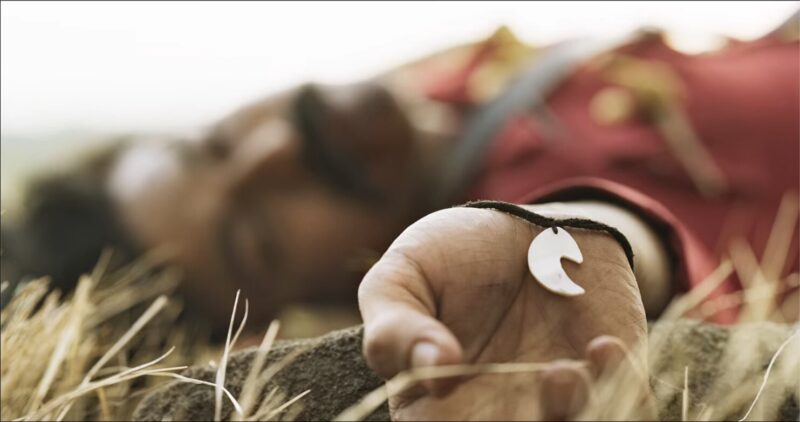
Pretty familiar, right? I paired these two images together because they each seemingly depict moments of defeat: Loki has lost her daughter, and Raju has failed his mission.
But really these moments serve as sources of inspiration. For Bheem, the “purchase” of Milli is what causes him to stop everything he’s doing and tend to his village. And for Raju, this pendant marks the moment he left his village and pursued a job in the Indian Imperial Force. The first shot shows how clueless the British Raj is about Bheem and Raju’s values, while the second shot highlights something more valuable than money.
Note that there are several more meaningful images throughout RRR that specifically use hands as important symbols (several of which we’ll observe in this article). Hands are often reaching for something desirable but seemingly unattainable—they serve as representations of both desire and inspiration. This shot from the opening scene lays the foundation for that recurrence.
The path of inspiration
Raju’s introduction is so awesome. The choreography of his giant brawl with hundreds of people is entertainingly shot and displays just how incredible of a fight he is. The entire scene illustrates just how determined he is to please the British Raj.
And while we might be confused about why he’s battling his own people at first, it is eventually revealed that he’s working undercover in order to supply his home village with weapons. Which makes the following image very important in retrospect:
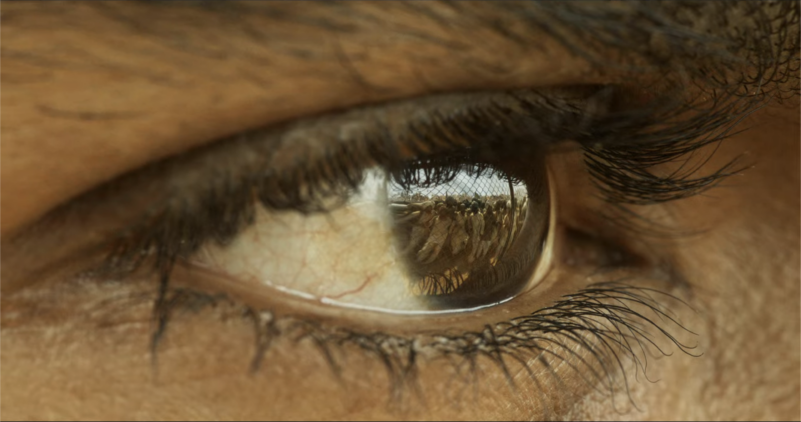
At first sight and without context, this image is cool to look at. This shot seems to highlight Raju’s savageness, his commitment to the British Raj. But it’s only later—after many emotional trials and tribulations and much bloodshed and betrayal—that we learn why this particular shot is so powerful. And it gains that power when we contrast it with one other specific moment from the film.
Throughout RRR, Bheem and Raju are constantly beaten down into submission. Just when you think they can’t escape? They find the willpower to push forward. And that determination inspires the people around them. You can find a contrasting image to the one above when Bheem is being tortured. In a moment where it doesn’t seem like he can go any further, he calls out to the crowd:
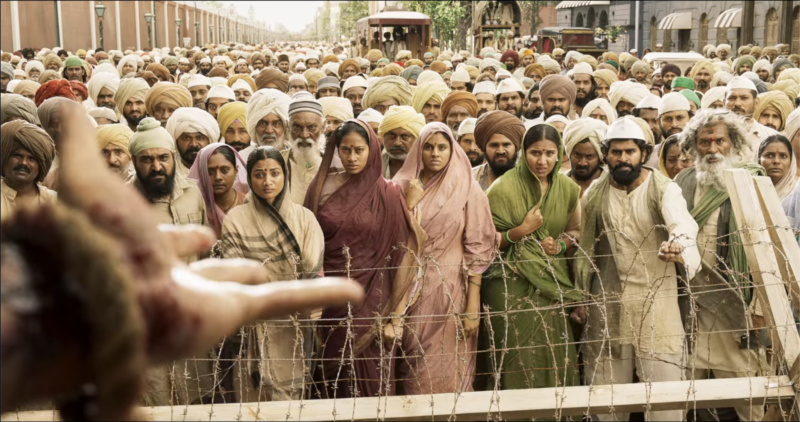
In the second shot, Bheem is reaching out to his people, desperately trying to inspire them. Again, this is another instance where hands play an important role. Both Bheem and Raju have to remember who they’re fighting for. And here, Bheem reaches out his hand to show everybody that he hasn’t forgotten, that he hasn’t given up. This action inspires everyone to revolt.
So in retrospect, that shot where Raju is looking out into the crowd is very powerful when contrasted with Bheem’s moment. Raju’s shot comes at the end of the fight when he’s obtained a wanted criminal and beaten up hundreds of men. Once we learn that Raju is secretly undercover and how difficult it was for him to hurt his own people, this particular shot gains a lot of ferocity and conflict. Raju has been forced to keep his emotions in check as he fights for the greater good.
The writer Mark Manson has a great article about understanding your emotions. In the piece, he argues that emotions are “your brain’s way of telling you something good or bad is happening in your life.” And…that’s about it. Manson says that emotions “are here to help us achieve our goals and find a sense of purpose. They are not the purpose themselves. And that’s where people get messed up. Most people mistake their emotions as the goals themselves. That is, a lot of people think that their emotions are all that is important.”
So when our emotions are all that’s important, we make rash, irrational decisions that can hurt us—which Raju cannot afford to do. That’s why in that shot where his eye is focused on his people, he must fight away tears and put on a face of impassiveness. He knows it’s the only way to win, to truly inspire people to stand alongside him and fight. His action is no different than Bheem reaching out to the crowd—it’s just taking a different path that will ultimately inspire people to rebel.
The power of camaraderie
Raju and Bheem are both great warriors, and they become even more powerful when they band together. But when they oppose each other? When they lose sight of their values? When they don’t communicate? Those opposing forces bury each other and they don’t make headway.
So the movie makes a point to test their relationship—narratively and visually. The narrative features two people fighting for the same thing, but dressing that fight with different motives. Bheem pretends to be Muslim so he can get close to Malli, while Raju prenteds to be part of the Indian Imperial Force to obtain guns for his village. They believe they are on opposing sides, but really they’re fighting for their families and they share the same values. Thus, there’s inherent tension in their relationship.
Visually, this tension is displayed with two particular shots. The inherent connection Bheem and Raju share is displayed from the get-go when a boy falls into the water and is surrounded by a burning ring of oil. From across the water, Bheem and Raju instantly connect with each other and form a plan via hand signals. And after they rescue the boy, they clasp their arms together in a moment of camaraderie:
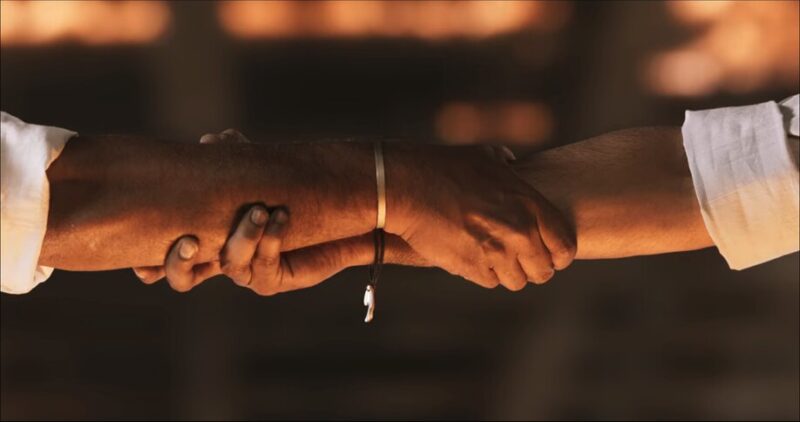
This is when we get the title sequence. The letters “RRR” stand for different things throughout the film, but in this moment, they spell out “Rise Roar Revolt.” As Bheem and Raju hold each other’s arms, this is the energy Rajamouli conveys. Separately, these two can surely rise up and make a difference. But together? The change they can create is endless. When they rise up, they should rise together. If they do that, the revolt they can inspire is gargantuan, the roar they share is amplified.
That’s why this image is copied almost verbatim in a contrasting moment later in the film. Bheem has broken into the British Raj’s grounds in an attempt to rescue Malli, but Raju has put a stop to his plans. Raju has managed to wrap a thread around Bheem’s hand and trap him. Knowing he’s been defeated, Bheem gives in. And Raju, knowing he can’t reveal his true intentions to his friend, cries a bloody tear onto his own hand. Which is when cut to this shot:
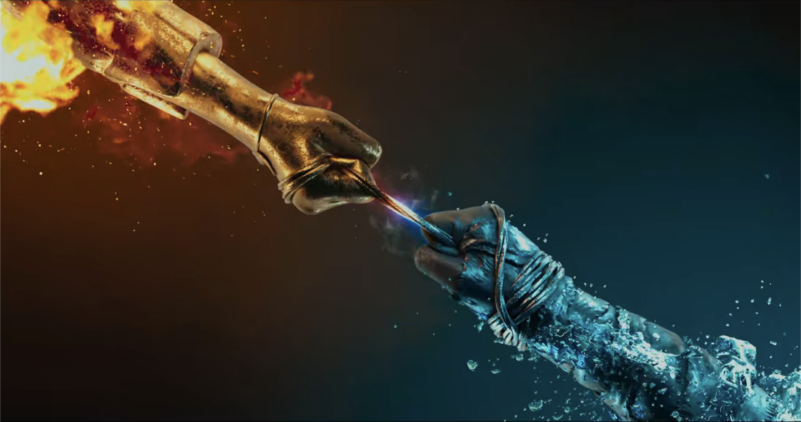
Notice how their arms aren’t touching, but are instead bound together by a string. This particular string is actually a “holy thread” that was worn by Bheem and was given to Raju when he was poisoned by the snake. When Bheem hands over his holy thread, a man says to him, “Removing it will only bring you problems.” To which Bheem responds: “He needs it more than me.”
The story behind this thread makes this shot all the more beautiful. Soon after this shot, we’re going to learn of Raju’s backstory and why he joined the Indian Imperial Force. So in this moment where Bheem is holding on by a thread (literally), we learn just how painstaking it is for Raju to betray his friend like this. By its very nature, by the manner in which it was given to Raju, this holy thread signifies their shared beliefs and culture—yet they cannot hold each other like they do after saving the boy.
This makes their shared connection both a physical and emotional one. Obviously their physical prowess allowed them to save the boy. But their psychological connection from across the lake is what truly puts them in sync. When they grab each other’s arms after rescuing the boy, there’s just as much warmth as there is tenacity. They are happy to have saved a life, and this shared experience creates a friendship. You can tell that they are truly happy to be around each other after that.
So when that shot of them holding each other’s arms is contrasted later by the holy thread, a new space is introduced between them. They have a lot to overcome before they can reunite physically and fight together once again. Their spiritual and emotional connection must be rekindled—which is what happens at the very end of the movie. So after this shot of the holy thread, they slowly work towards building their camaraderie and banding together once again.
Breaking free from confinement
One recurring motif throughout the film is confinement—or, more specifically, the desire to break free from confinement. There are several shots of people trapped behind bars, unable to be with their loved ones. The bars make matters worse, as freedom is still in sight on the other side. Yet they remained trapped by the British Raj. The prison becomes symbolic of how the Indian people feel trapped in their own country.
The earliest moment where someone is stuck behind bars occurs when Bheem gets inside the palace and finds Malli. Bheem recognizes her singing voice and locates her room, but is unable to free her from her imprisonment. They touch each other, cry together, yearn together—but are unable to actually be with each other:
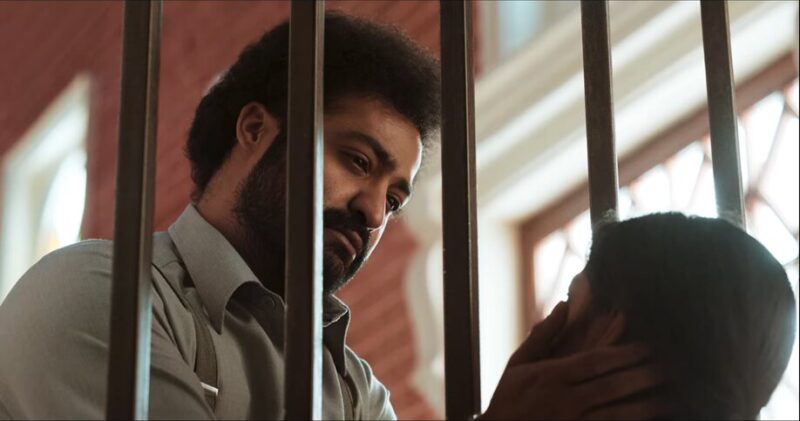
Malli is just a little girl. There’s not much she can do for herself here, so it’s upon people like Bheem and Raju to save her. But that’s also the point of using Malli to first establish the motif of confinement: it serves as motivation for our heroes to break her (and their people) free from oppression.
That’s why in subsequent shots throughout the film, we see Raju and Bheem persevering through imprisonment. Whether it’s Bheem failing to kneel while being tortured or Raju performing pull-ups while in solitary confinement, our heroes are constantly pushing themselves to remain strong, to never subject themselves to defeat in front of their people. That determination is ultimately what drives their people to rise up and revolt—and what inspires one another to keep fighting.
And that inspiration comes to fruition at the end of the movie. Bheem sneaks into the British Raj grounds and finds Raju in solitary confinement. And in a moment that’s strikingly similar to Bheem’s moment with Malli behind bars, he and Raju share a connection while Raju is trapped:
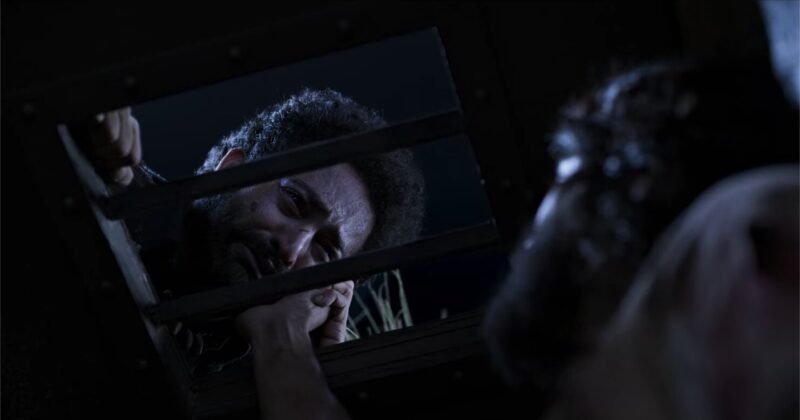
Here, Bheem cries just as he did with Malli. But this time, it’s not because of how bad he feels for a little girl who can’t defend herself—instead, he’s sorry that his actions led to Raju’s imprisonment. And ever since he lost Raju in his life, he’s been missing a piece of himself he thought he would never get back.
That drives the emotion of this moment. Bheem doesn’t think he deserves forgiveness, but Raju understands what’s more important. They need to band together once again and break free from this physical prison, this cultural prison imposed by British rule. That energy is what drives them to fight back in this final scene of the film and overcome oppression.
Becoming your own god
Throughout this article, we’ve identified several motifs that involve rising up and fighting back. The characters of this film are constantly down and out—only to find the strength within and carry on. And obviously that inspiration comes from the people around you. But it also comes from your culture and beliefs. You must fully embody your doctrine, your ideals to become a realized individual.
In a sense, you must become your own god. You can certainly pray to a god and believe in something greater than yourself. But to truly bring those beliefs to life—to become a breathing manifestation of the gods and live by their divine concepts—that requires you to become a god.
For the record, there’s nothing blasphemous being said here. It’s a common philosophical talking point known as pantheism, which is the “belief that reality is identical with divinity, or that all things compose an all-encompassing, immanent god or goddess.” Or as this article from The New Indian Express puts it, “God is your making.”
I believe RRR recalls this very idea at the end of the movie. Before the final scene of the film, Bheem and Raju are great warriors who can battle tigers and take down soldiers—but they have yet to become deities that conquer oppression, to be forever immortalized by their people, to inspire change for generations to come. That is until the very end when Raju transcends his mortal bodies and becomes something greater and embodies divinity.
The moment is teased in this shot when Bheem takes Seetha’s hands and promises to bring Raju back:
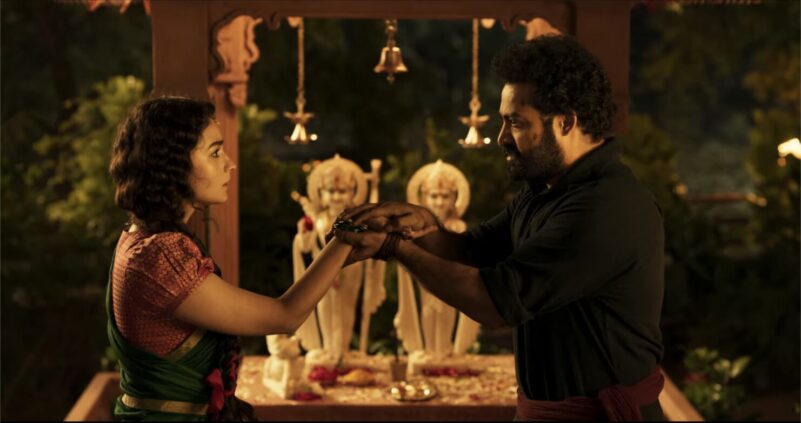
Notice those two statues in the background? They are Lord Ram and Mother Sita from a famous Indian story called the Ramayana. It turns out that the entire movie borrows the story from this and another Hindu epic: the Mahabharata. While Raju and Bheem serve as fictionalized versions of two real-life Indian revolutionaries (Alluri Sitarama Raju and Komaram Bheem), they also become embodiments of two gods featured in those legends: Ram is depicted by Raju, and Bhima depicted by Bheem. In addition, Seetha comes to represent Ram’s wife Sita.
In that moment where Bheem promises to bring Raju back to his wife, what he’s really promising is to bring that story of the gods to life. This is a demarcation point in his life: the Ramayana is no longer just a story, but a creed by which to live your life. Bheem is going to will Raju and Seetha’s reunion into existence.
And that’s exactly what Bheem does—which is what inspires Raju to take a divine leap. In the forest, Bheem comes across an even bigger statue of Lord Ram, who wields a bow and several arrows. Bheem then adorns Raju with the bow and the attire worn by Lord Ram, which in turn creates a god out of Raju:
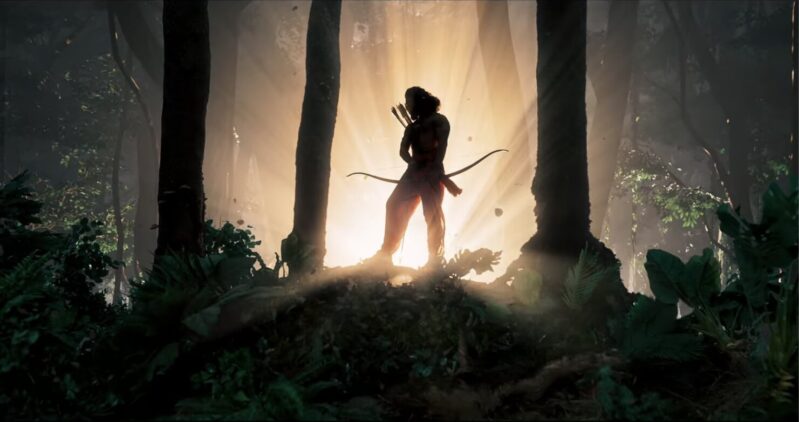
This is the climactic moment of the movie. From this point forward, there is no stopping Raju. He has elevated himself to a higher plane in order to free his people and reunite with his wife. As a deity, he is now in a position to win the fight and create a legend that will inspire people for generations to come.
That’s what makes Raju and Bheem’s conversation at the end of the movie so emotional. Raju says to Bheem, “You’ve taken me closer to my ambition. You’ve given me this attire that will inspire me to fight. What can I offer you in return?” To which Bheem replies, “Teach me, brother.” Raju nods, and a song in the background sings: “There is an iron man in every lane and home.”
This leads to the closing scene of the movie, when Raju and Bheem perform a dance number with a crowd of people and honor various revolutionary figures in India’s history. That quote, “There is an iron man in every lane and home,” shows that anybody can find that god within and become an inspiration for change. We, in fact, just witnessed one in the form of Raju. And now Bheem wants to be taught how to achieve it as well.

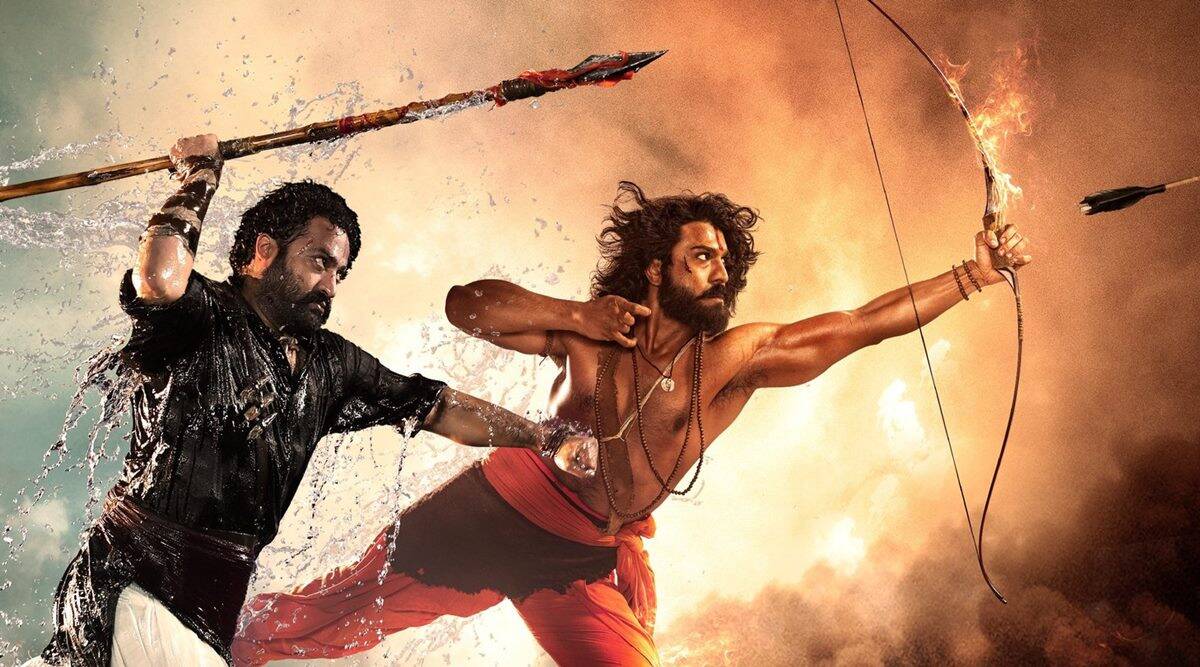
Coins/Blood tear shots are highlight of the movies
Why u didn’t touched ‘one African man says many things without uttering single word in Naatu song’?
“Anybody can find that god within and become an inspiration for change” – just amazing analysis Travis.
Very well written. It was inspiring as like the movie.
Thank you!
Travis, you understood the movie much better than 99% of the audience that watched it.
Thanks for taking the effort to do so…
I appreciate that!!
Just fascinated by the fact how deep you went explaining this!
Thank you! It was fun to spend this much time with the movie. Helped me understand and appreciate it even more!
Well Done Travis!
You missed one point. Bheem is a shepherd and he was chained and beaten but he doesn’t break. It was Jesus Christ tribute.
That is a pretty well-written piece. Shows your love for the Art.
That was beautifully written, and you absolutely got the essence of many scenes. You seem to have connected with Indian culture through the movie in ways that were missed by many reviewers. In Indian culture, values, family and duty are indeed held much higher than emotions.
A few more points below:
– Bheem becomes Hanuman and returns Ram to his Sita, instead of the other way round as the Ramayana goes. This was a gorgeous piece of adaptation from Rajamouli.
– I interpreted the reflection of the crowd in Raju’s eyes in the closeup shots to indicate his countrymen as his true ulterior motivation in doing what he’s doing
– And finally, many Indian people consider the cultural appropriation of Yoga, Murtis (statues) sealed in museums and the frivolous use of divine imagery as meaningless decor to be equivalent to the image of Loki lying beaten unconscious with the useless coins.
Thank you for a beautiful piece!
Thank you for the kind words!
There are a few corrections to the story about the locket. I have indicated all of that on my thread on twitter. Check it out. Travis and Chris, would you like to work on a video with me explaining various motifs used in RRR. My e-mail is obviously is here and I am in the US. Please feel free to correct with me if interested. I have also added your article to my tweet. Excellent explanation of some of the issues. https://x.com/hemanth_kundeti/status/1604888942779604993?s=20&t=UMLkWYJrEbslYhECSN8_bA
Ramayan and Mahabharat are not mythological epics. They are called Itihasa, which means “As it was at that point in time”. It cannot get more real than that.
Wow I didnt knew that this much of detail had in every shot of this movie, thank you sharing, you are truly a art appreciator.
Thank you!!
Thanks for the clarification! I removed the word “mythological.”
Excellent write up!🙏🙏🙏
Thank you!!
Wow, Amazing post.. Rajamouli is a genius he actually told the whole plot of the movie in the scene where RAM and BHEEM meets. Bheem came to rescue a child while Ram came for freedom. If you see the scene Bheem handovers the child to Ram while Ram gives the Flag to Bheem which as we know happens later in the movie. Ram bringing Malli to Bheem and Bheem bringing guns for Ram.
Yeah, it’s a fantastic movie!
The words on the flag are “Water. Forest. Land”
Ah, thank you! I was curious if the subtitles actually reflected what was written on the flag.
That,s such a great article. Awesome writing just like the how awesome RRR is…
haha yes I had quite a lot to live up to! Thank you
Really amazed by the way you caught those detailing… You showed a different perspective of every aspect of those shots…thanks for the information
Appreciate that! It was fun to go back through the moment and find these connections 🙂
Simply beautiful! Well written piece
Thank you so much!!
Rama and Sita are from the Ramayan epic, not Mahabharata. Bheem is from Mahabharata. You also missed how both had connections with water and fire I suppose, as well the locket of Ram and Sita which was in the epic, where Ram sends his locket with Hanuman (Character which inspired creation of Monkey King and Journey to the west) and Hanuman goes to Lanka to Sita and shows that locket to her. as a proof of him being Ram’s Messenger. So some of the stuff you missing out is understandable since you don’t know much about this Hinduism lore nor do I have deep knowledge about it so I’m guessing even I missed some symbolic moments so if you really want more thrill, more joy from the movie do some research on them and you’ll love the movie more.
There are a few corrections to the story about the locket. I have indicated all of that on my thread on twitter. Check it out. https://x.com/hemanth_kundeti/status/1604888942779604993?s=20&t=UMLkWYJrEbslYhECSN8_bA